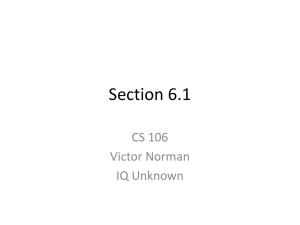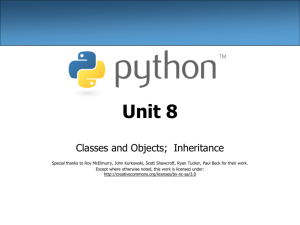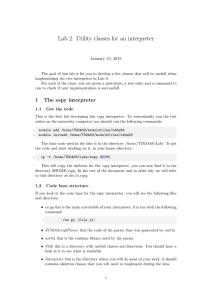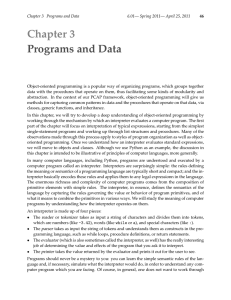Q and A for Sections 6.2, 6.3 Victor Norman CS106
advertisement
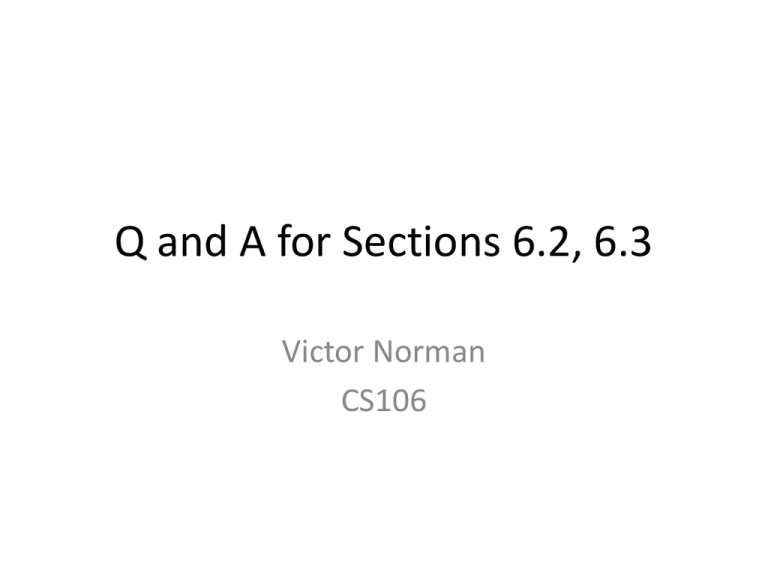
Q and A for Sections 6.2, 6.3 Victor Norman CS106 Parameterized Constructor Q: Can you create multiple constructors for a class, so that you can create new objects in different ways? A: No. You can have only 1 __init__ definition. But you can use optional parameters to allow the caller to create objects in multiple ways. Remember: in general, a constructor should initialize all its member attributes to values. Example class Card: def __init__(self, num=2, suit=“H”): “””Create new card. If num and suit are not specified, it is a 2 of hearts.””” self._num = num self._suit = suit card = Card() card2 = Card(11, “S”) # 2 of hearts # jack of spades Exercise Given this definition, write the accessor and mutator methods. class Car: def __init__(self, numWheels=4, color=“black”): self._numWh = numWheels self._color = color How does __str__ get called? • Special methods get called by the python interpreter when they are defined in a class. • e.g., __str__(), if defined, is called by python whenever the object must be converted to a string – like when str(obj) is called or print obj is called. • in other words: the python interpret sees this: print obj. – It looks up the class of obj, and checks if __str__ has been defined for it. If so, it calls it to get the string representation for it. Otherwise, it calls a built-in way to convert it – usually resulting in something like <__main__.Obj instance at 0x1007a4098> What other special methods are there? • https://docs.python.org/2/reference/datamo del.html • Especially useful: __cmp__(self, other): compare two objects __contains__(self, item): called when in is used __add__, __sub__, __mul__, etc.: x + y x.__add__(y), based on x’s type. Which special methods must we know? __init__ __str__ __cmp__ (others, like __add__, are occasionally useful…) NOTE NOTE NOTE: do *not* define your own methods with __ before and after. Polymorphism • Means: operators/functions (like +, -, abs(), len(), in, and, +=, %) may behave completely differently, based on the types of their operands. • Also known as “operator overloading” • “Josh ” + “Bulten” concatenation • 1 + 4 addition • [‘Go’] + [‘Calvin’] append jumpPrevChannel() code • Television class has two attributes: _channel, _prevChan. • Wrong: self._channel = self._prevChan self._prevChan = self._channel • Need to swap values: easiest with tuple assignment: self._channel, self._prevChan = self._prevChan, self._channel isinstance() • returns boolean • Very useful for checking types of input parameters to a function/method • isinstance(object, (tuple, of, types)) boolean • if not isinstance(param, (int, float)): print “Illegal parameter!” • (We’ll learn how to handle this better next week, with exceptions.) Objects that reference other objects • Very common to have multiple classes, and objects in one class reference other classes. • E.g.: deck object has a list of card objects. – Always want to store objects – not, e.g., string representations of objects. • Important to get the methods in the correct classes. Calling methods from methods Q: Is calling a method within a method definition similar to calling a function from within another function? A: Yes and no. Yes: control is transferred to the method and returned back when the method completes. No: you have to use self.calledMethod() to do the call. Example class Hand: def __init__(self, ……): … def isStraight(self): … def isFlush(self): … def isStraightFlush(self): ‘’’return True if this hand is a straight flush, False otherwise.’’’ return self.isFlush() and self.isStraight() Two-dimensional arrays/lists • Often in modeling the world, we need to use two-dimensional arrays of “cells”. • We can model many different things with 2d arrays: – landscapes – petri dishes – mini-world – matrix • store as a list of lists. 2D lists • Like putting turtles on the screen, the 2d array has a width and height. • Typically x is horiz, y is vertical. Often (0, 0) is upper-left corner. • If world is your 2d list, then we access by world[x][y] • x is column index, y is row index (or, y is the item in the y-th row in the x-th column) • world[x] is a column. Initializing a 2D list (list of lists) • Want MAXCOLS columns and MAXROWS rows, each holding subsequent integers from 0. – for 3x4 array: world = [ [0, 1, 2, 3], [4, 5, 6, 7], [8, 9, 10, 11] ] MAXROWS = 3 MAXCOLS = 4 world = [] for x in range(MAXCOLS): # create MAXCOLS lists world.append([]) val = 0 for col in world: # add MAXROWS items to each column for y in range(MAXROWS): col.append(val) val += 1 Exercise: average neighbors • Write code to find the sum of 4 neighbors of cell at x, y, assuming cell is not on an edge. sum = world[x-1][y] + world[x+1][y] + world[x][y-1] + world[x][y+1] Example: Teams, Players Write a class definition for a Player class. Each Player object has these attributes: • • • • • • _name _number _age _position _salary _team Write the constructor definition. Continued Write a class definition for a Team. Each Team object contains • • • • • _name _players addPlayer() delPlayer() getTotalSalary() Write the constructor (setting name and players). Write addPlayer(). Continued Want to be able to print out this for a player: Peyton Manning, #18, QB, Denver Write the code to do this. Continued Write the code for getTotalSalary() in Team.

